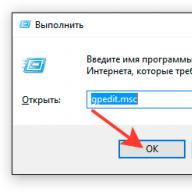Properties of nonlinear two-poles usually describe them static characteristics. The generally accepted characteristic of a nonlinear resistive two-pole is its volt-ampere characteristic (WA).
Static Wah. – this is the dependence of the current flowing through a nonlinear resistive element, from the voltage attached to itin the steady mode (or vice versa - the dependence of the voltage drop on the element from the current flowing through it).
Static VAC determines the properties of the element with a low voltage (current) of a low frequency, the value of which does not exceed the maximum valid value.
Depending on the number of external conclusions distinguish nonlinear bipolar elements (resistors with nonlinear resistance, electrovacuum and semiconductor diodes) and nonlinear multipole elements (transistors and thyristors of various types, electricallyakuum triodes and pentoders).
The battery of the nonlinear bipolar element may be symmetric (Fig.15.2, a) or asymmetric (Fig.15.2, b, c) relative to the start of coordinates.
Fig.15.2 - static volt-ampere characteristics of various
resistive elements
For symmetrical Wah, a condition is true I.(U.) = -I.(-U.), and for asymmetrical I.(U.) - I.(-U.).
Obviously, the mode of operation of the nonlinear chain will not change if the conclusions of the nonlinear resistive element with a symmetric characteristic change places.
Distinguish nonlinear resistive elements with monotonna (Fig.15.2, a) and nonmonotonic (Fig.15.2, b, c) Wah.
Elements S.monotonna Wah An increase in the voltage applied to the element leads to an increase (or at least a decrease) of the current and, on the contrary, an increase in current leads to an increase in voltage on the element.
Voltage and current on the clips of such an element are interconnected unambiguous addiction, and the derivatives of the Wah in all its currents take only non-negative meanings.
 ,
, .
.
The batter of the nonlinear element isnonmonotonic If at least in a limited range of changes and voltages changes in the voltage at the element clips leads to a decrease in current or, on the contrary, an increase in current leads to a decrease in voltage.
The current and voltage of the non-linear resistive element with non-monotonic WAH are not interconnected with each other (Fig.15.2, b, c).
The variety of all batteries of nonlinear two-poles can be reduced to six main types (Fig.15.3, A-E).

Wah may have insensitivity zones, i.e. "Step" by voltage or for current (Fig.15.4, a, b)

The type of nonlinear resistive two-hectare can depend on some values \u200b\u200bthat are not directly related to currents or voltages of the chain, which includes this element, in particular on temperature, illumination, pressure, etc. Such elements relate to non-electrically manageable two-pole.
Since each value of the control value corresponds to its curve, which characterizes the dependence between the current and the voltage at the clips of a non-electrically controlled resistive two-pole, and two-hectares are not characterized by one flux, but the family of the Wah (Fig.15.5).

Fig.15.5 - Family of the thermistor.
The most important class of nonlinear resistive elements make up electrically controlled elements (Different types of transistors, vacuum and gas-discharge three-electrode and multi-electrode devices. Elements of this type contain two main electrodes:
Cathode and anode in electronic lamps;
Emitter and collector at bipolar transistors;
Stoke and source in field transistors.
The resistance between the main electrodes changes under the action of the current or voltage of one or more control electrodes:
Grids in electronic lamps;
Bipolar transistors;
Shutter or substrate in field transistors.
In particular, current i. Nonlinear resistive three-pole (Fig.15.6) having two basic and one control electrode, is the function of voltage between the main electrodes u. And current control i. UPR or voltage u. UPR control electrode:
|
|
i. = i.(u., i. UPR) i. = i.(u., u. UPR). |
Fig.15.5 - Electrically controlled nonlinear threepole
As can be seen from Fig. 15.5, an electrically controlled nonlinear resistive three-pole has two sides: input (control) and output (controlled), and one of the conclusions of the three-pole is common to both sides.
Electrically controlled nonlinear resistive elements can be characterized by various families of the Wah.
Weekend Wah Displays the dependence between output currenti. and output voltageu. With different input current valuesi. aplative or voltageu. aplative .
Typical weekend Wah bipolar transistor in a circuit with a common emitter (Fig.15.6, a) are presented in Fig. 15.6, b.

The complete classification of nonlinear elements is presented in Table 15.1, and examples of nonlinear resistive elements with their conditional graphics and volt-ampere characteristics are shown in Table 15.2.
|
Resistive |
1. By type of parameter |
Signs of classification |
Tab.29.1 - classification of nonlinear elements |
|
Inductive |
|||
|
Capacitive |
|||
|
Two-pole |
2. By the number of external conclusions |
||
|
Multi-pole |
|||
|
Symmetric |
3. According to the presence of Symmet Rii Wah |
||
|
Asymmetrical |
|||
|
Monotonous |
4. According to the presence of monotone whales |
||
|
Nononotonic |
|||
|
Current saturation |
5. By type Wah |
||
|
Tension saturation |
|||
|
S-type (current ambiguity) |
|||
|
N-type (ambiguity of voltage) |
|||
|
With current insensitivity |
6. According to the presence of insensitory zone |
||
|
With voltage insensitivity zone |
|||
|
Without the insensitivity zone |
|||
|
Neelectric managed |
7. By way of management |
||
|
Electrically controlled |
Table 15.1 - Resistive NE
|
Element, graphic designation |
Characteristic |
|
|
Two-pole resistive elements |
||
|
Varistor |
|
Symmetric I.(U.) = -I.(-U.), monotonna
|
|
Electrovacual diode
|
|
Asymmetric, monotonous flush (dI/du) > 0 |
|
Neon lamp
|
|
Wah with a falling plot ( dI/du) < 0, asymmetric, non-monotonic, |
|
Semipipes-nick diode |
| |
|
Stabilirton |
|
Wah asymmetric, monotonous |
|
Tunnel diode |
|
WAT with a falling area, asymmetric, non-monotonic, n-type |
|
Non-electrically controlled bipolar resistive elements |
||
|
Thermistor. |
|
Wah with a falling area, resistance depends on temperature |
|
Photodiode |
|
Resistance depends on light flux |
|
Electrically controlled three-pole resistive elements |
||
|
Bipolar transistor type n.- p.- n.
|
Weekend Wah |
Wah is asymmetrical, monotonne, with current saturation. The output current depends on the voltage and from the input current: I. K \u003d. I.(I. B, U. CE) |
|
Thyristor |
|
Wah is asymmetrical, nemonotonic, S-type, depends on voltage on the control electrode |
2.2. Static and Differential Parameters
For resistive nonlinear elements, their resistance is an important parameter, which, unlike linear resistors, is not constant, and depends on which point it is determined. Distinguish two types of resistance: static and differential (dynamic).
Static resistance characterizes the operating point of the nonlinear DC element, and the differential is the operation of the nonlinear element in the vicinity of this operating point.
Suppose the resistive nonlinear element has a volt-ampere characteristic indicated in Figure 15.8.

Static resistance - This is the ratio of voltage to the current at this point of the Wah.
 (15.1)
(15.1)
where  - large-scale coefficient;
- large-scale coefficient;
m. u, m. I - the scale of voltage and current;
- an angle of inclination of the sequential, conducted through the origin of the coordinates and the operating point to the axis of currents.
Static resistance - This is the resistance of the nonlinear constant current element.
Obvious static conductivity There is a quantity, inverse static resistance
 (15.2)
(15.2)
- This is the limit of the ratio of the increment of the voltage to the appropriate increment of the current with a slight displacement of the working point on the WHA under the influence of alternating voltage of small amplitude:

Differential resistance – this is the resistance of the nonlinear element of the alternate current of the small amplitude.
Ministry of Education and Science of the Russian Federation
Federal State Budgetary Educational Institution of Higher Professional Education "Magnitogorsk State Technical
University. G.I. Nose "
Department of Electrical Engineering and Electrical Systems
O.I. Petukhova, L.V. Yabbarova, Yu.I. Mamleev
Nonlinear Chains Analysis Methods
1.1. Nonlinear items and their characteristics 3
1.2.3. Calculation of chains with mixed connection of elements 7
1.2.4. Transformation of active nonlinear two-pole 8
1.2.5. Analysis of branched chains 10
1.3. Approximation of the characteristics of nonlinear elements 12
1.3.1. Choosing an approximating function 12
1.3.3. Approximation of Wah in the vicinity of the working point 18
2. Magnetic chains 19
2.1. Basic concepts 19.
2.2. Ohm and Kirchhoff laws for magnetic chains 21
2.3. Calculation of DC magnetic circuits 23
3.1. Features of periodic processes in electrical circuits with inertial nonlinear elements 27
3.2. Features of periodic processes in chains with uninterrocious nonlinear resistances 30
3.3. Electromagnetic processes in the coil with ferromagnetic core 31
1. Nonlinear chains
1.1. Nonlinear items and their characteristics
The characteristics of most real elements are non-linear to one degree or another. In some cases, the nonlinearity of the elements is small and when building a simplified model it can be neglected, in others it is impossible to neglect nonlinearity. Moreover, the functioning of most radio-electronic devices is impossible without nonlinear elements (straightening, multiplication, restriction, generation, etc.).
Real nonlinear elements are divided into erroneous inertial. If the dependence between instantaneous current values \u200b\u200band voltage of elements at a periodic exposure is determined by the static volt - ampere characteristic (WA), the element refers to non-airliner elements. If the static flock and dynamic, removed at a frequency equal to or less working, do not match, then such an element should be considered a kaine.
Thus, the inertial nonlinear element is linear relative to instantaneous values \u200b\u200bof current and voltage, and the binding values \u200b\u200bof the valid values \u200b\u200bturns out to be non-linear. Union melements are nonlinear as in relation to instantaneous values.  ,
, and with respect to existing
and with respect to existing  and
and  .
.
Depending on the number of external conclusions, nonlinear elements of bipolar (diodes, thermistors) immunity (transistors, triododes, pentoders) are distinguished. Volt is the ampere characteristic of the nonlinear bipolar element can be symmetric or asymmetric. The two-pole battery with a symmetric characteristic is shown in Fig.1. For it, condition is satisfied:
 ,
,
 .
(1)
.
(1)
Obviously, the mode of operation of the nonlinear circuit will not change if the output of the nonlinear element with a symmetric characteristic is changed in places. If condition (1) is not performed, the Wah is asymmetrical.
The ratio of the voltage measured by the segment of AV to the current measured by the segment of the OH (see cris 1), determines on some scale  static resistanceR at point A.
static resistanceR at point A.
 (2)
(2)
The limit of the ratio of the increment of the voltage on the circuit section to the increment of the current in it or derivative of the current voltage on the same scale  Defines the differential resistance:
Defines the differential resistance:
 .
(3)
.
(3)
There are nonlinear elements with monotonous nonmonotonic. For monotonnets  or
or  always more zero.
always more zero.
Nemonotonic characteristics are divided into N-and S-types. In elements with N-shaped characteristic (Fig. 2.a), several different voltages can correspond to the same current value. In S-figs, one voltage value may correspond to several currents (Fig. 2.b).

Fig.2. Wah different nonlinear elements
a) NemonotonicN.-Type; b) NemonotonicS. - type;
c) WAH non-electrically managed two-pole - thermistor.
The type of the nonlinear element can depend on some values \u200b\u200bthat are not associated with currents and voltages of the chain into which the element is turned on, in particular on temperature (Fig. 2.V), illumination, pressure, etc. Such elements relate to kneelectric controlled two-pole .

Fig.3. Electrically managed element
a) transistor; b) family of entrance cars;
c) Family of the weekend.
The most important class of nonlinear elements make up electrically controlled elements (transistors, thyristors, etc.). They have two main electrodes and one control (Fig. 3.A). Current  the element is determined by the equations:
the element is determined by the equations:
 or
or  .
(4)
.
(4)
The conclusions of the nonlinear controlled three-solid car form with the rest of the chain two contours - the main (output) and the control (input).
Controlled elements are characterized by the families of the WAY: output and input. (Fig. 3.b, c)
The view of the nonlinear controlled element is significantly dependent on the inclusion scheme of the element, i.e. From which one of the electrodes is common to the main and control circuits. On the fundamental electrical circuits, real nonlinear elements are depicted using the Conditional graphic designations established by ECC (Fig. 4).

Fig.4 Designations of nonlinear elements
1. Basic provisions |
|||||
R a \u003d. |
R ABR CA. |
||||
R B \u003d. |
R BCR AB |
||||
R BC + R Ca |
|||||
R C \u003d. |
|
R AB + R BC + R CA. |
By mutual substitutions in the obtained expressions, we can obtain expressions for R AB, R BC and R Ca (i.e., expressions for the conversion of a star into a triangle):
R AB \u003d R A + R B + R A R B;
R bc \u003d R b + r C + R b R c;
R Ca \u003d R C + R a + R c R a.
1.5.1. General
Nonlinear electrical chain this is an electrical chain containing one or more nonlinear elements [1 ] .
Nonlinear elementthis is an element of an electrical circuit, the parameters of which depend on their determinants (resistance of the resistive element from current and voltage, the capacitance of the capacitive element from charge and voltage, inductance of the inductive element from the magnetic flux and electric current).
Thus, the volt-ampere U (i) characteristic of the resistive element, Weber-ampere ψ (i) The characteristic of the inductive element and pendant-voltage Q (U) The characteristic of the capacitive element is not the form of a straight line (as in the case of a linear element), but some The curve usually defined experimentally and does not have an accurate analytical representation.
Nonlinear electrical chain has a number of significant differences from linear and specific phenomena may occur in it.

1.5. Nonlinear electric chains |
||||||||
Fig. 1.28. Hugo nonlinear resistive, inductive and capacitive elements
(for example hysteresis), so this methods for calculating linear circuits to non-linear chains are not applicable. It should be noted that inapplication to the nonlinear chains of the application of the application (superposition).
It is important to understand that the characteristics of real elements are never linear, but in most engineering calculations they, with permissible accuracy, can be considered linear.
All semiconductor elements (diodes, transistors, thyristors, etc.) are nonlinear elements.
Conditional graphic designations of nonlinear resistive, inductive and capacitive elements are shown in Fig. 1.28. On the remote area, the parameter causing nonlinearity is specified (for example, the temperature for the thermistor)
1.5.2. Parameters of nonlinear elements
Nonlinear elements are characterized by static (R st, L, and C st) and differential (R d, L d, and c d) parameters.
Static parameters the nonlinear element is defined as the ratio of the ordinate of the selected point of the characteristic to its abscissa (Fig.1.29 ).
Static parameters are proportional to the tangent of the angle of the straight, conducted through the origin of the coordinates and the point for which the calculation is calculated. For example in fig. 1.29 We get:
F Art \u003d y a \u003d m y Tg α, x a m x
where α-- the angle of the tilt forward spent through the origin of the coordinates and the operating point A;
m y and m x - scale in the axes of the ordinate and the abscissa, respectively.

Fig. 1.29. To the definition of static and differential parameters
nonlinear elements
F Art \u003d Y A, F DiF \u003d DY X A DX
From here the static parameters of resistive, inductive and capacitive elements will have the following form:
R st \u003d. |
L Art \u003d. |
C st \u003d. |
|||||||||
Differential parametersthe nonlinear element is defined as the ratio of the small increment of the ordinate of the selected point of the characteristic to the small increment of its abscissa (Fig. 1.29).
Differential parameters are proportional to tangent tongue angle at the operating point characteristics and an abscissa axis. For example in fig. 1.29 We get:
F DiF \u003d DY \u003d M Y TG β, DX M x
where β is the angle of inclination of tangent at the working point B characteristics and the axis of the abscissa;
m y and m x - scale in the axes of the ordinate and the abscissa, respectively. Hence the differential parameters of the resistive, inductive
and capacitive elements will be as follows:
R DIF \u003d. |
L DIF \u003d. |
C DIF \u003d. |
||||||||
1.5.3. Methods for calculating nonlinear chains
The nonlinearity of the parameters of the elements complicates the calculation of the chain, therefore, they are trying to choose either a linear, or close to it, the characteristics and are considered, and considered, with permissible accuracy, element as linear. If it is impossible or non-linearity characteristic is the cause of the choice of the element (this is especially characteristic of semiconductor elements), they use special calculation methods - graphic, approximation
(analytical and piecewise linear) and a number of others. Consider these methods in more detail.
Graphic method
The idea of \u200b\u200bthe method is to construct the characteristics of the elements of the chain (volt-ampere U (i), Weber-ampere ψ (i) or pendant-volt Q (U)), and then, by their graphic transformations (eg addition), obtaining the corresponding characteristic For the entire chain or its site.
The graphical method of calculation is the most simple and visual application, providing the necessary accuracy in the bulk of the calculation, but it is applicable to a small number of nonlinear elements in the chain and requires accuracy during graphic constructions.
An example of calculating the nonlinear circuit with a graphic method for a sequential connection of linear and nonlinear resistive elements is shown in Fig. 1.30, and, for parallel - in Fig. 1.30, b.
When calculating the sequential chain in the same axes, the characteristics of all calculated elements are built (for the example under consideration, it is U NE (I) for the nonlinear resistor R NE and Ulu (i) for linear R LE). The nature of the change in total voltage in the circuit U (i) is determined by the addition of the characteristics of nonlinear U NE (I) and the linear U LE (I) of the elements U (I) \u003d U NE (I) + U LE (I). Addition is made at the same current value (for i \u003d i 0: u 0 \u003d U na 0 + U Le 0, see fig. 1.30, a.).
The calculation of the parallel chain is made similarly, only the characteristic of the entire circuit is built by the addition of currents, at a constant voltage (for u \u003d u 0: i 0 \u003d i na 0 + i LE 0, see Fig. 1.30, b.).

Fig. 1.31. Active linear two-joint as a diagram of substitution of a nonlinear element
Approximation method
The idea of \u200b\u200bthe method consists in replacing the experimentally obtained characteristics of the nonlinear element by an analytical expression.
Distinguish analytical approximation at which the characteristic of the element is replaced by an analytic function (for example, lineary \u003d ax + b, ste-
som y \u003d a th βx and others) and piecewise
neurina, in which the characteristic of the element is replaced by a set of rectolic
nehine segments. Accuracy of analytical approximation
measures are determined by the correctness of the selection of the approximating function and the accuracy of the selection of coefficients. The advantage of piecewise linear approximation is the simplicity of use and the ability to consider the element as linear.
In addition, in a limited range of signal changes in which its changes can be considered linear (i.e. in small signal mode), a non-linear element, with permissible accuracy, can be replaced by an equivalent linear active two-component (Fig. 1.31, a two-component two-joint will be considered in § 2.3.4), where the current and voltage are linked by the expression:
U \u003d E + Radiff I,
where R diff is the differential resistance of the nonlinear element on the linearizable area.
An example of an analytical approximation The characteristics of the semiconductor diode using the function of the form I \u003d A (E BU - 1) is shown in Fig. 1.32, b, piecewise linear approximation - in Fig. 1.32, B, the initial characteristic of the diode is shown in Fig. 1.32, a.

Fig. 1.32. Approximation Characteristics of the semiconductor diode.
a - the initial characteristic of the diode;
b - analytical approximation using the function of the form I \u003d A (E BU - 1);
b - piecewise linear approximation.
The characteristics of most real elements are non-linear to one degree or another. In some cases, the nonlinearity of the elements is small and when building a simplified model it can be neglected, in others it is impossible to neglect nonlinearity. Moreover, the functioning of most radio-electronic devices is impossible without nonlinear elements (straightening, multiplication, restriction, generation, etc.).
Real nonlinear elements are divided into erroneous inertial. If the dependence between instantaneous current values \u200b\u200band voltage of elements at a periodic exposure is determined by the static volt - ampere characteristic (WA), the element refers to non-airliner elements. If the static flock and dynamic, removed at a frequency equal to or less working, do not match, then such an element should be considered a kaine.
Thus, the inertial nonlinear element is linear relative to instantaneous values \u200b\u200bof current and voltage, and the binding values \u200b\u200bof the valid values \u200b\u200bturns out to be non-linear. Union meters are nonlinear both in relation to instantaneous values, and in relation to valid and.
Depending on the number of external conclusions, nonlinear elements of bipolar (diodes, thermistors) immunity (transistors, triododes, pentoders) are distinguished. Volt is the ampere characteristic of the nonlinear bipolar element can be symmetric or asymmetric. The two-pole battery with a symmetric characteristic is shown in Fig.1. For it, condition is satisfied:
Obviously, the mode of operation of the nonlinear circuit will not change if the output of the nonlinear element with a symmetric characteristic is changed in places. If condition (1) is not performed, the Wah is asymmetrical.
 The ratio of the voltage measured by the segment of AB to the current measured by the segment of the OH (see cris 1.), Determines the static resistance R at the point A.
The ratio of the voltage measured by the segment of AB to the current measured by the segment of the OH (see cris 1.), Determines the static resistance R at the point A.
![]() (2)
(2)
The ratio of the ratio of the voltage increment on the chain section to the increment of the current in it or the voltage derivative of the current on the same scale, determines the differential resistance:
There are nonlinear elements with monotonous nonmonotonic. For monotonnets or always more zero.
Nemonotonic characteristics are divided into N-and S-types. In elements with N-shaped characteristic (Fig. 2.a), several different voltages can correspond to the same current value. In S-figs, one voltage value may correspond to several currents (Fig. 2.b).

Fig.2. Wah different nonlinear elements
a) non-monotonic N-type; b) non-monotonic S type;
c) WAH non-electrically managed two-pole - thermistor.
The type of the nonlinear element can depend on some values \u200b\u200bthat are not associated with currents and voltages of the chain into which the element is turned on, in particular on temperature (Fig. 2.V), illumination, pressure, etc. Such elements relate to kneelectric controlled two-pole .

Fig.3. Electrically managed element



















